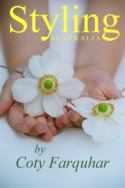I won't try to name everyone who offered a response, but I truly appreciate their input and their expertise. Mimi said it's Gooseneck Loosestrife, adding "it can be rather invasive, so you might want to watch it closely! It has taken over one corner of my flowerbed...I will have to do some serious eradication this fall!"
 Below is where it's growing on the property. It's easy to see how the word, gooseneck, became associated with Lysimachia clethroides, with their slender arching spikes of white flowers.
Below is where it's growing on the property. It's easy to see how the word, gooseneck, became associated with Lysimachia clethroides, with their slender arching spikes of white flowers. It's in a wide border on the left, facing the house, at the top of our "sunken garden."
It's in a wide border on the left, facing the house, at the top of our "sunken garden." Its tendency to be aggressive is somewhat contained here.
Its tendency to be aggressive is somewhat contained here. Looking toward the house (it was early morning).
Looking toward the house (it was early morning). The gooseneck longstrife has to overcome English ivy and monkey grass if it wants to take over the steeply sloping area leading down to the garden.
The gooseneck longstrife has to overcome English ivy and monkey grass if it wants to take over the steeply sloping area leading down to the garden. Stone steps lead to the area below -- they're not as treacherous as the camera angle would make it seem.
Stone steps lead to the area below -- they're not as treacherous as the camera angle would make it seem. I'm using loosestrife in my next tablescape post. Here's a peek:
I'm using loosestrife in my next tablescape post. Here's a peek: And an overview. I hope you'll be back to see the rest!
And an overview. I hope you'll be back to see the rest!If you want to know even more, here's an excerpt from an article by Gerald Klingaman, retired Extension Horticulturist from the University of Arkansas:
Gooseneck loosestrife is a 24- to 30-inch foot tall, fast-spreading, herbaceous perennial in the primrose family. It is a neat and tidy grower with lots of elliptical, mostly glabrous leaves densely crowding the erect stems. In the fall there may be a bit of yellow fall color.
From early- to mid-summer a nodding, terminal spike of white flowers is produced atop each stem. Small, individual non-fragrant flowers have five petals and are to one-quarter-inch across. When plants first flower, the spike is about 4 inches long. Later in the summer it will extend to about a foot. Plants continue flowering as long as the soil stays moist and temperatures do not get too high.
Most of the 180 Lysimachias are native to Europe or Asia. This species is widely distributed in China and Japan where it grows in moist mountain meadows, near streams and along roadways.
The Website-based public opinion poll shows a divided gardening electorate. About one-third have a negative view of gooseneck loosestrife, one-third are positive and one-third hasn’t made up its mind. Many in the neutral category have grown it for only three to four years so their opinion may become more negative over time.
Gooseneck loosestrife’s detractors uniformly condemn its invasive root system. It spreads widely by white rhizomes, especially if planted in moist, fertile soil.
About 15 years ago I planted a plant in a dry, partially shaded bed where oak roots predominate; today the clump is about 6 feet across. If you don’t like, or are afraid of bamboo, then you probably should not plant gooseneck loosestrife.
This plant is hardy from zone 4 through 9 and has a decided preference for bright, rich, moist sites. Gooseneck loosestrife will grow in full sun or medium shade. Its growth rate is checked considerably by shade and summer drought. It is not well suited for inclusion in the mixed border or the small garden because of its thuggish ways. However, plants with invasive roots can be grown by containing the roots in a buried container.
On larger properties gooseneck loosestrife can be used for naturalizing along stream overflow areas or at the interface between woods and open ground. It can be used as an herbaceous groundcover in areas where its spread can be controlled by mowing or a natural barrier such as water or a walk. Its spread is only by means of its rhizomes, not by seed.
Gooseneck loosestrife should not be confused with purple loosestrife (Lythrum salicaria), the escaped ornamental that has become a common weed of waterways in the northern states. Purple loosestrife and gooseneck loosestrife, though they share a common name, are in completely different families.
I hope you all have a great week!















If I didn't live in a flat now, I'd be hotfooting it to my local nursery to get some of those delightful plants, Bill, lol. I don't think they'd do very well on my tiny balcony :o)
ReplyDeleteHave a great week too.
Dear Bill,
ReplyDeletesuch a nice plant. But invasive is not always a problem. Such as bamboo are a serious problem because one will hardly get the roots ever out of the garden. But some plants are easy to weed. So when such plants are invasive it causes not a hard problem but they are usually easy growing and that's what I appreciate. The sunken garden looks so romantic.
You made me curious with your pretty centerpiece and the peek at the table. But I would have looked at you TT anyway because I am always curious with what new ideas you came.
Greetings, Johanna
What a tease showing the flowers and a overview of the table!!
ReplyDeleteI see you have two healthy "mother in laws tongues" ( Sanseveria trifasciata)in pots.
Will be back to see the tablescape as usual!!
Jackie in UK.
Bill,
ReplyDeleteI am glad you let us know what the flower was. We have loosestrife here but it is purple. Very, very invasive and threatening shorelands.
Look forward to your tablescape.
Carol
Thanks for the mention. Bill, your garden is so lush, and all that shade, something I don't have in my yard...almost all sun.
ReplyDeleteTeaser...I wanted to see more of your beautiful floral arrangement...guess I will have to wait until TT! I love using grasses, in the fall I like to use wheat.
Oh so, so pretty!!!! That arrangement is lovely!
ReplyDeleteSuzanne
So glad to see your garden. Good to learn about loosestrife.
ReplyDeleteLooking forward to your next post. Your arrangements always give me a happy feeling and inspire me. Growing up my aunt always had fresh flowers from her garden in every room. Your arrangements remind me of hers. Thanks.
I would plant some of that and let it grow. It is pretty and much more attractive then some stuff in my garden! Thanks for the info and the tease!!!
ReplyDeleteThis is great information! Thank you for sharing the name and info with us. You should link up to Outdoor Wednesday if you haven't already! Lots of avid gardners participating in that would love to see your yard. Your backyard is almost as stunning as your tablescapes! Absolutely beautiful!
ReplyDeleteBill, I missed your post where you asked to identify this beautiful but invasive plant. I had it in my perenial garden and it went crazy. It took it over by force. In our township, it is against the law to plant gooseneck loostrife anymore.
ReplyDeleteIt is lovely in your arrangement, and I am so looking forward to seeing this previed table! OOOOOOOOhhhh! So pretty from my vantage point!
Yvonne
Bill-I am glad to know the answer. I had no idea what it was, but it is beautiful. I'll take your word for it on those steps :0)--look pretty steep to me!
ReplyDeleteRight..that is what it was. Tip of my tongue I tell you.
ReplyDeleteI must say if I ever get to Tennessee I would love a tour of your beautiful property and home.
It's a pretty plant and perfect for bouquets! It looks like you have a great spot for it! Can't wait to see your table -- I'm green at that tablecloth!
ReplyDeleteIt certainly looks beautiful in your garden~ I'm admiring that lovely, cool, green shady path on this upper 90 degree day. Looking forward to seeing more of your arrangement & tablescape :-)
ReplyDeleteThanks for all the information on Gooseneck Loosestrife. I've purchased some of these blooms as cut flowers for arrangements. I may check into growing some myself as long as I can figure out a way to control it. :-)
ReplyDeleteBeautiful table setting! One of my favorite things about your TT posts is the variety of locations that you set your tables. ~ Sarah
Oh my goodness - a peek at your beautiful property!! LOVE those steps! Oh, Bill, you have such a lovely garden, outdoors, and home. You'd better thank the good Lord every day!
ReplyDeleteBest regards,
Gloria
Oh so "sweet!"
ReplyDeleteJoyce
As always, this is amazing. And I still feel that it speaks of elegance of a bygone era, even with the various pieces/not quite as formal as what you sometimes do! Still magnificent!!! I love those etched glasses, too, will check them out.
ReplyDeleteYour incorporation of fresh flowers always adds a touch of organic allure. Your photography is artful and your writing informational (as a former journalist, I mean that as a compliment) AND aesthetic, which concurrently tell a rich interior design story each week that you present something. Yes, indeed, your tablescapes and vignettes are stories that enchant.
Hugs,
Lana
Bill, Your garden is beautiful and I am glad you shared all this information about gooseneck loosestrife and also purple loosestrife. Very interesting!
ReplyDeleteBeth